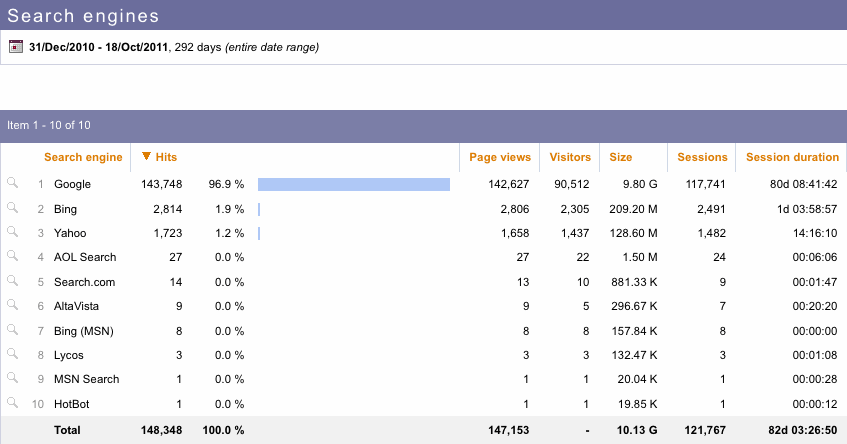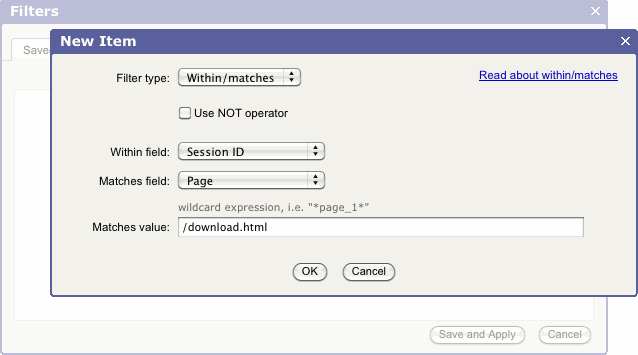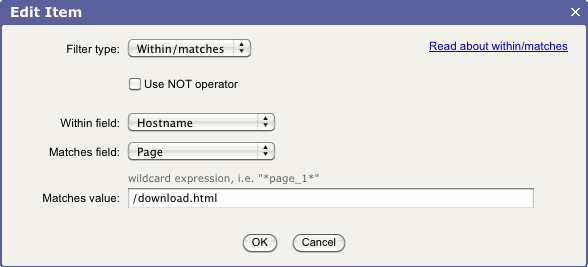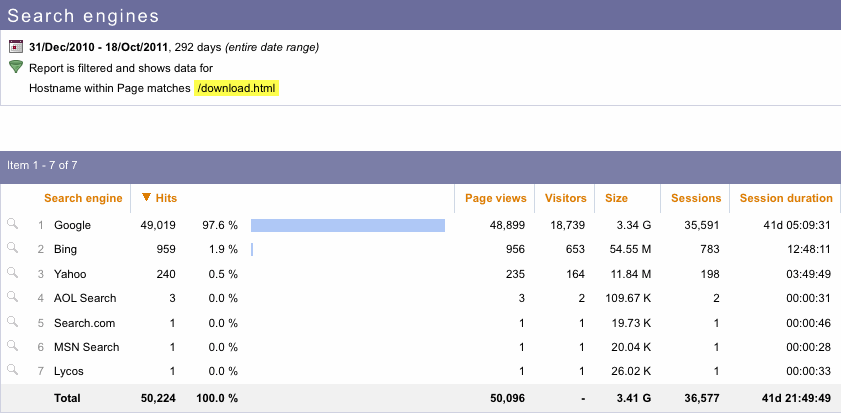Newsletters
 |
Sawmill Newsletter October 20, 2011 |
Welcome to the Sawmill Newsletter!
You're receiving this newsletter because during the downloading or purchase of Sawmill, you checked the box to join our mailing list. If you wish to be removed from this list, please send an email, with the subject line of "UNSUBSCRIBE" to newsletter@sawmill.net (please include the entire message, as the identifying information is at the bottom).
News
Sawmill 8.5.1 is now available. This is the final, production release of the new Sawmill 8.5 version, which is a major upgrade to Sawmill 8. It is also a free upgrade to Sawmill 8 (though your profiles and databases will need to be converted). You can download Sawmill 8.5.1 from http://sawmill.net/download.html . Please send your feedback about your experiences with Sawmill 8.5.
Sawmill 7 users can upgrade to Sawmill 8 for half of the license price; or if you have Premium Support, the upgrade is free. Major features of Sawmill 8 include support for Oracle and Microsoft SQL Server databases, real-time reporting, a completely redesigned web interface, better multi-processor and multi-core support, and role-based authentication control.
This issue of the Sawmill Newsletter gives an example of the use of the Within/Matches filter, a new feature of Sawmill 8.5, to do conversion tracking, including multi-session conversion tracking.
Get The Most Out Of Sawmill With Professional Services
Looking to get more out of your statistics from Sawmill? Running short on time, but need the information now to make critical business decisions? Our Professional Service Experts are available for just this situation and many others. We will assist in the initial installation of Sawmill using best practices; work with you to integrate and configure Sawmill to generate reports in the shortest possible time. We will tailor Sawmill to your environment, create a customized solution, be sensitive to your requirements and stay focused on what your business needs are. We will show you areas of Sawmill you may not even be aware of, demonstrating many streamlined methods to get you the information more quickly. Often you'll find that Sawmill's deep analysis can even provide you with information you've been after but never knew how to reach, or possibly never realized was readily available in reports. Sawmill is an extremely powerful tool for your business, and most users only exercise a fraction of this power. That's where our experts really can make the difference. Our Sawmill experts have many years of experience with Sawmill and with a large cross section of devices and business sectors. Our promise is to very quickly come up with a cost effective solution that fits your business, and greatly expand your ROI with only a few hours of fee based Sawmill Professional Services. For more information, a quote, or to speak directly with a Professional services expert contact consulting@flowerfire.com.
Tips & Techniques: Using The Within/Matches Filter For Conversion Tracking
Users of Sawmill 8.1 and earlier may be familiar with the "session contains" filter, a report filter which selects all events in sessions which hit a particular page. With the advent of snapon-based session analysis in Sawmill 8.5, this filter is no longer available, but a newer, more general filter, the Within/Matches filter, takes its place. This newsletter gives an example of using Within/Matches to do conversion tracking, by generating a report of all search engines which brought traffic which eventually converted (downloaded, in this example).
The Unfiltered Search Engines Report
For this 15 million line dataset, the Search Engines report looks like this, without any filters:

Unfiltered Search Engines
This report shows which search engines brought traffic to the web server, and how many visitors and sessions each brought. Most hits on a web server are "internal" hits, i.e., clicks from one page of the web site to another, so their immediate referrer is within the site. Search engines, and other "external" referrers, are the initial hits of each session.
That's very useful information by itself, but many of these sessions will be fleeting visitors, who look at the site and then leave, without "converting." Conversion happens when the visitor does what your site wants them to do, whether that means buying a product, downloading a file, signing up for a newsletter, or something else. This web site provides file downloads, so a "conversion" in this case is a hit on the downloads page, /downloads.html . The Pages report will tell us how many times that page was hit, but the crucial question is: where did those converting visitors come from? From an advertising standpoint: which campaigns brought the converting visitors, and should therefore be continued? Which campaigns did not bring enough conversions to be worth their price?
The Within/Matches Filter
The Within/Matches filter can answer this sort of question. The filter is somewhat complicated to explain, but easier to understand when it's in action. In this case, we're using it to select all events from converting sessions (and later, from converting hosts); in particular, we're selecting the first events from converting sessions, which gives us the initial referrer from that session, which gets us the search engine that brought the conversion. Here's the filter, as entered in the Filters window while viewing Reports:

Within/Matches with Session ID
Here's how it works. A "fieldX within (fieldY matches 'Z')" filter starts by finding all hits in the data, where fieldY matches the wildcard expression Z. From that set of hits, it finds all values of fieldX, and finally selects (for the report) those rows where fieldX is one of those fieldX values it found. For instance, if Z is /downloads.html and fieldY is Page and fieldX is Session ID, as it is in the example, it starts by finding all hits where the Page is /downloads.html . Then, it finds all Session IDs for those hits, i.e., the IDs of all sessions (as computed by Sawmill's Sessions snapon) which at some point hit /downloads.html . Finally, it selects all events where the Session ID is one of those Session IDs; i.e., it selects all hits from all sessions which at some point hit /downloads.html .
This filter can be applied to any report, but it's particular interesting in referrer-based reports like Search Engines:

Search Engines [With Filter: Session ID Within (Page Matches /downloads.html)]
This report shows the Search Engine field values for all events in those sessions which hit /downloads.html , so it shows the search engines which occurred in the sessions which eventually downloaded, i.e., the search engines which brought downloading sessions.
Multi-Session Analysis with Within/Matches
The report above, however, doesn't show the search engine if the referral from the search engine wasn't in the same session as the download. If a user comes from Google, and browsers the site, and then leaves; and they later return and download, it would still be nice to show that as a conversion from Google, but since it has a different Session ID, Within/Matches isn't going to select the session with the Google referrer. The solution is very simple: use the hostname field instead of the Session ID field (this, by the way, is where Within/Matches is much more general and more useful than the older "session contains" filter, which couldn't have done this analysis):

Within/Matches with Hostname
Because this filter selects rows where the hostname is the same as the hostname of downloads, it takes session analysis entirely out of the picture, and simple selects all hits from those hostnames who eventually downloaded. This effectively creates a multi-session analysis, looking back to the very first event from the hostname, and finding from it the referrer that brought them to the site. With this filter, we see many more referrers:

Search Engines [With Filter: Hostname Within
(Page Matches /downloads.html)]
These include the referrers who brought converting sessions, but also include all the other referrers for converting hostnames: the referrers which brought sessions which didn't convert, but were followed by later sessions from the same hostname which did convert.
Advanced Applications
We've discussed using session ID, and hostname, to identify users. Other options are also possible. In particular, if you use JavaScript to assign a unique cookie to each user (e.g., using Sawmill's own loganalysisinfo.js script), and you populate a database field from that cookie, you can use that instead, to identify users. This is sometimes better than hostname, because the hostname/IP field can be dynamic, so future visits by the same person may show up as a new hostname, and not be correlated as a conversion by Within/Matches. Also, if the site logs people in by username, and includes the username in the log files, you can use the username field instead, as yet another way to identify visitors.
Above, we showed the Search Engine report, which is certainly a useful one. Other useful reports are Search Engine by Search Phrase, or Search Phrase alone, which shows not just which engine brought the converting traffic, but also what they searched on there. The Referrers report can show exactly which links brought the converting traffic, which is a simple way of tracking advertising campaign effectiveness. A more sophisticated approach is to extract and report advertising campaigns as a separate field, typically by using a URL parameter in the ad target links (e.g., http://www.mysite.com/?campaignID=123); if you're populating a database field with the ID of the advertising campaign, and have a custom report for that field, it is easy to view your custom Campaigns report with a within/matches filter, showing how many conversions you got from each campaign.
The Holy Grail analysis, however, is one which integrates with a store to show dollars generated per campaign. Given product information (including pricing) in the URL, or in a file referenced by a portion of the URL, it is possible to create a Campaigns report which shows not just how many conversions (purchases) each advertising campaign brought, but how much revenue it generated. This is a fairly advanced analysis, typically requiring exporting of store price lists to a CFG file, which is then queried by a log filter using an order ID from the URL, and then populated into a custom "revenue" numerical field, which becomes part of the within/matches-filtered referrer-based reports. It can theoretically be done by any Sawmill report user, but due to the complexity of the task and the amount of Sawmill expertise required, this is an excellent use of Professional Services (see below).
Professional Services
This newsletter describes the use of Within/Matches filters for conversion tracking. Simple conversion tracking can be done easily by any Sawmill report user, but the more advanced conversion tracking options require considerably expertise to implement. If you need assistance implementing advanced conversion tracking and ad campaign analysis, our Sawmill Experts can help. Contact consulting@sawmill.net for more information.
[Article revision v1.0]
[ClientID: 2]